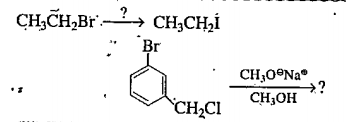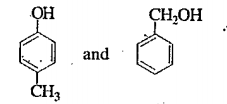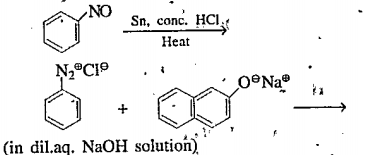Complete Solutions to EXERCISE of chapter HIGHER SECONDARY EXAMINATION 2017 of Class 12 book with complete answers and questions
| Class 12 | CHEMISTRY |
| Chapter | HIGHER SECONDARY EXAMINATION 2017 |
| UNITED BOOK HOUSE | EXERCISE |
| Number Of Questions | 70 |
| Academic Year | 2023-24 |
The quantity of electricity required to electrolyse separately 1 M aqueous solutions of `ZnSO_4`, `AlCI_3` and `AgNO_3` completely is in the ration of.
View SolutionWhat is the formula of the oxide formed on burning potassium in oxygen?
View SolutionWhen tetraminechloridonitritio cobalt (III) nitrate is dissolved in water, how many ions will be formed on molecule?
View SolutionWhich of the following compounds is formed when phenol is heated with `CCI_4` and NaOH?
View SolutionWhich of the following is a biodegradable polymer?
View SolutionA compound X is used as an antiseptic in 0.2% solution and as a disinfectant in 1% solution. Which of the following is X?
View SolutionWhich of the following exists as covalent crystals in the solid state-
View SolutionThe process by which alum purifies turbid water is
View SolutionWhich one of the following atomic numbers is that of a lanthanoid element ?
View SolutionWhich of the following compounds most readily undergoes solvolysis by `S_(N)1` mechanism ?
View SolutionIn the solid state which of the following is the structure of alanine?
View SolutionWhich of the following is not a food preservative?
View SolutionMark the hydrophobic and hydrophilic parts of the following syn-thetic detergen

View SolutionAtoms of which two elements among the following are of same size ? Zr, Fe, Ru, Sc, La, Hf
View SolutionWhat would be the value of paramagnetic spin moment of `K_3[Fe(CN)_6]`? (Atomic No. of Fe=26)
View SolutionFor which phenomenon colloidal particles do not settle down?
View SolutionIt 193000 coulomb of electricity is passed through a metallic wire, how many electrons will flow through the wire?
View SolutionWrite the appropriate Nernst equation for the following half-cell reaction: `MnO_4^-(aq) +8H^+(aq)+5erarrMn^(2+)(aq)+4H_2O (I)`
View SolutionWrite down the van't Hoff equation for osmotic pressure of a solution. State, with reason , whether all solutions obey this equation.
View SolutionWhen urea is added to water the freezing point decreases. Explain why.
View SolutionA U-tube is completely filled with `Fe(OH)_3` sol and a potential difference is applied by Pt electrodes immersed in each of the two arms. Towards which electrode will the sol particles move and why?
View SolutionDefine heterogeneous catalysis with an example.
View SolutionHow will you distinguish chemically between `HN_3 and HN_3` ?
View SolutionWrit down the balanced chemcial equation for the reaction of `H_2S` with aqueous solution of `SO_2` and write the roles (oxidant/reductant) of the reactants in the reaction.
View SolutionExplain why `Cu(NH_(3))_4]^(2+)` ion is coloured but `[Cu(CN)_4]^(3-)` ion is colourless.
View SolutionWhat are the two monomer units of terylene? Write the repeating unit of terylene.
View SolutionWhat is the ferromagnetic substance?
View SolutionKBr crystallises in face-centered cubic (fcc) crystals. The density and formula mass of KBr crystal are `2.65 g cm^(-3)` and `119 g mol^(-1)` respectively. Find the distance between `K^+ and Br^-` ions in KBr crystal.
View SolutionWhich kind of defect in ionic crystals does not alter the density ?
View SolutionAn element X has atomic mass `60 g mol^(-1)` and density `6.23 g cm^(-3)`. The edge length of its unit cell is 400 pm. Identify the type of the unit cubic cell. Calculate the radius of X atom.
View Solution20 g of a solid solute is dissolved in 180 g of water. At `100^(@)C` the vapour pressure of the solution becomes 740 mmHg. Calculate relative molecular mass of the solute. (No association/dissociation of the solute takes place )
View SolutionWhat is the fuel cell? Write down anodic reaction and cathodic reaction of a hydrogen oxygen fuel cell. Give one use of fuel cell.
View SolutionDefine specific conductivity ?
View SolutionA current of 35 ampere is passed through acidulated water for 5 minute 50 second. How many gram of hydrogen will be liberated at the cathode ? [1F = 96500 coulomb]
View SolutionWrite self-reduction process with balanced chemical reaction in the extraction of copper from copper matte. Why is the process called 'self-reduction'?
View SolutionA green oxide of chromium(A), on fusion with KOH and `KNO_3` gives a yellow compound (B). The aqueous solution of (B) on acidification with dilute `H_2SO_4` gives an orange coloured compoud (C). Identify (B) and (C) and write down balanced chemical equations involved.
View SolutionComparing `La(OH)_(3)` and `Lu(OH)_(3)`, which is more basic and explain why?
View SolutionWrite the IUPAC name mentioning R/S notation of the following compound:

View SolutionWrite the reagent in case of first reaction and the organic product in cast of the second reaction.

View SolutionWrite one use of dichloromethane and one harmful effect of it on human body.
View SolutionIdentify A, B, C, D, E and F in the following reactions:

View SolutionIdentify A, B, C, D, E and F in the following reactions:

View SolutionIdentify A, B, C, D, E and F in the following reactions:

View SolutionIdentify A, B, C, D, E and F in the following reactions:

View SolutionWrite the mechanism of the following reaction: `CH_3CH_2OHoverset(conc.H_2SO_4(excess))underset(443K)(rarr)CH_2=CH_2`
View SolutionHow can the following two isomeric compounds be distinguished by a chemcial test?

View SolutionWrite down the reagents for the following reactions:

View SolutionWrite down the reagents for the following reactions:

View SolutionWrite the organic products of the following two reactions:

View SolutionWhat are meant by aldose and kethose? Write with examples.
View SolutionWrite the name and biological function of a protein hormone.
View SolutionStarting from the rate law of a first-order reaction how that the half-life of the reaction is independent of the initial reactant concen-tration.
View SolutionThe rate equation for the chemical reaction:
`aA+bB+cCrarreE+fF` is expressed as -
rate `=k[A]^(alpha)[B]^(beta)[C]^(0)`
Determine overall order and molecularity of the reaction.
View SolutionIn a multi-step chemcial reaction, which elementary step is con-sidered as the rate determining step?
View SolutionHow does a catalyst enhance the rate of a chemical reaction? At a constant temperature, does the enthalpy of chemical reaction remain same or change in presence of a catalyst?
View SolutionAccording to collision theory of reactions, Why all molecular collisions do not result in effective collision?
View SolutionHow does `PCI_3` undergo hydrolysis?
View SolutionWrite with balanced chemical equation, what happens when chlorine gas is passed through hot concentrated KOH solution.
View SolutionWrite the thermal stability order of hydrogen halides.
View SolutionAn organic compound has the molecular formula `C_2H_4O_2`. Write the structures and names of two compounds with this formula.
View SolutionHow would you convert?

View SolutionHow would you convert? `CH_3CH_2COOH rarrCH_3CHCICOOH`
View SolutionHow would you convert?

View SolutionHow would you convert?

View SolutionIdentify A, B, D, E, F, G in the following reactions:

View SolutionName two solid elements which on combination give a liquid compound.
View SolutionWhen aniline reacts with oil of bitter almonds condensation takes place and benzal derivative is formed. This is known as:
View SolutionIdentify A, B, D, E, F, G in the following reactions: `CH_3COCH_3+SeO_(2_3)overset(CH_3COOH)(rarr)E` (organic compound)
View SolutionIdentify A, B, C, D, E and F in the following reactions: `CH_3COCH_3 overset(Ba(OH)_2rarrC`
View SolutionGive the stability order of Black, Red, White Phosphorus.
View Solution
EXERCISE questions and complete solutions for chapter HIGHER SECONDARY EXAMINATION 2017 of UNITED BOOK HOUSE of Class 12